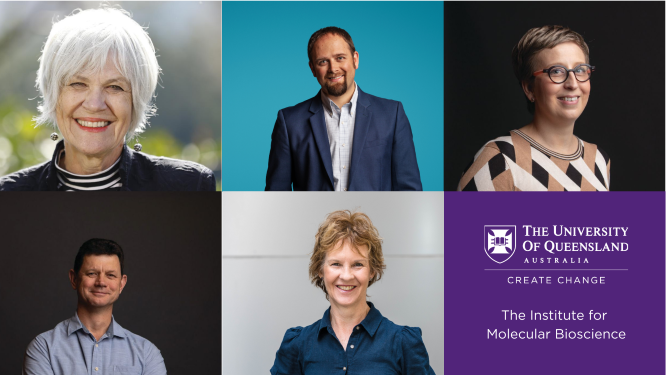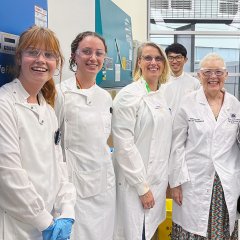As a privileged cis-woman living in Australia in 2025, I have the right to work, to learn, to healthcare and sanitary products. I have opportunities to pursue my personal and professional goals. And yet, at our current rate of action, full gender parity won’t be reached until 2158.
In a developed country like Australia, there’s a common assumption that equality has been achieved. In fact, according to a 2024 survey of more than 24,000 people, Gen Z men- our young adults- are more likely than any other group to believe gender equality has ‘gone far enough’. But the data tells us a staggeringly different story, particularly across academia and research. Here at The Institute for Molecular Bioscience (IMB) only 30% of group leaders are women. That’s a figure echoed by both The University of Melbourne and the Australian Research Council [3, 4].
This chronically leaky pipeline is costing Australia powerful researchers and leadership so as a scientist I ask, how can we accelerate action in research to better represent the women of the world?
IMB faced these issues head-on at their International Women’s Day panel and fundraising event for Dress for Success. Whilst delayed because of Brisbane’s first cyclone in 50 years, the institute still arrived in force to listen to our research experts, joined by Ms Elizabeth Watson-Brown (MP for Ryan), to discuss how research can accelerate action for gender and diversity equity in research.
So-called ‘women’s health issues’ are repeatedly underfunded and undervalued, as the need for sex and gender equitable studies across every field has historically been discounted. In biological females Heart attacks display different symptoms. Sex differences in vaccines create variability in safety and efficacy. Females disproportionally experience chronic pain. And our understanding of mental health conditions is far behind what we know in males.
Today, the 2016 Sex and Gender Equality in Research (SAGER) guidelines outline the best practices for sex and gender information in research. Professor Kate Schroder explained how her research group applies sex and gender guidelines: “For many of us working with animal models in human disease, it’s critical to address sex bias. Your models must reflect real-world data—take Alzheimer’s, for example. Two-thirds of patients are women, so we power our models to represent that.”
Despite these efforts the unanimous message was clear: that funding remains the biggest barrier to balancing sex differences in research. Panellists noted that designing sex-balanced studies can effectively double costs—requiring more staff, time, equipment, and analytical resources. Researchers undoubtably want to produce reliable, reputable work that considers all variables. But, if a lack of funding is making equitable research practices unattainable, then I would argue: no, we have not taken advocacy far enough.
All researchers emphasised the importance of more robust sex- and gender-focused science. Professor Nathan Palpant pointed to a growing presence of sex and gender-focused sessions at conferences and increasing reporting of differences in published papers. Professor Matt Sweet added that “The first part of the SAGER guidelines is about getting our terminology right” —a tangible, achievable step for any lab, institute, university, or industry player.

(bottom-left) Professor Matt Sweet, Professor Denise Doolan
But real change goes beyond the research itself. Addressing the career imbalances entrenched in science is fundamental to achieving any real progress. Women in leadership create workplaces where people feel heard, are more inclined to put forward new ideas and collaborate on projects, improving productivity and workplace fulfilment. Even then, The University of Melbourne reported in 2023 that despite women making up more than half the academic workforce, senior academic roles (levels D and E) were overwhelmingly held by men.
Meanwhile, more junior academic roles (Levels A and B) are held equally, in some cases more often, by women. With only 22% of senior academic positions at IMB held by women and female researchers across Australia fighting for representation in senior academic roles, it’s clear that women are being barred- structurally or culturally - from advancing into leadership.
Among myself and my peers, the same concerns echo: lack of funding, unconscious bias, and the challenge of balancing other roles women carry throughout life. Just as a researcher begins to hit her stride professionally, life often demands more at home. Maternity leave, caring for children, and supporting family all take time—time that the relentless publish-or-perish culture doesn’t account for.
This isn’t to say male researchers don’t face similar pressures. But the reality remains, while women are increasingly ‘allowed’ to work and lead, the societal expectation to manage the home, perform domestic duties, and shoulder the bulk of caregiving hasn’t shifted accordingly.
The passion for research I see in those around me is exciting, I’m lucky to have incredible female role models in science. But it was sobering to learn that every female panellist, including Elizabeth Watson-Brown, had no such role models in their early careers. Professor Denise Doolan shared how she is working towards “making it up to the next generation to try and identify the areas where progress is needed”.
She also highlighted the importance of tangible support, like access to childcare and dedicated research funding for returning carers, as critical steps institutes can take to support women and carers. While women are working hard to build a better future for others, the real shift must come from a deeper change in mindset. Fundamentally we need to reframe what it means to be ‘productive’ in a system that was not designed to support the reality of community needs.
The panellists closed with some words of advice for young researchers.
There’s a tendency for women to make themselves smaller. To be seen as kind, approachable, and non-threatening we pad our emails with exclamation marks, maybe a smiley emoji, soften questions with ‘if it isn’t too hard’ or ‘If you have some spare time’ – slipping into what some have termed, good girl syndrome. The challenge lies in being visible and confident without being perceived as overbearing. When asked how to avoid falling into these gender roles Elizabeth Watson-Brown highlighted “Maybe it’s time for the boys to be ‘Good Girls’? This is seen as a negative, because of this paradigm we have been working in, this hyper-aggressive, combative, environment and we know that’s not how we achieve things”.
Her sentiment was echoed by Professor Kate Schroder who explained “I recognise that it's most important to stay true to my values and our mission as a lab… I try and be a friendly leader rather than everybody's best friend.”
Professor Denise Doolan added that “you’ve got to be able to say no,” highlighting the emotional labour women often carry.
The message to me was clear, women shouldn’t continuously try and change themselves to fit an outdated idea; be small enough to be kind and considerate while simultaneously big enough to be heard over the cacophony of other voices, opinions, and ideas. As I grow as both a scientist and a leader, I’m learning that strength is about being grounded in your values, yet flexible enough to evolve. Balancing the ability to speak up while also listening— making space for all voices.
Time and again, women have stood up for women. But now the question is, how will systems and governments stand up for women? How can research stand up for women? How can communities, teams, schools, universities, companies, industry, and individuals stand up for all women?
In the face of growing global uncertainty, it’s easy to feel powerless. But change begins with honest conversations—about where we fall short, how we move forward, and the actions we’re willing to take. That’s how we accelerate progress in research, and in the world.
Author: Samara Ranie



